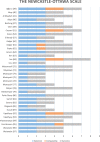Role of anatomical sites and correlated risk factors on the survival of orthodontic miniscrew implants: a systematic review and meta-analysis
- PMID: 30246217
- PMCID: PMC6151309
- DOI: 10.1186/s40510-018-0225-1
Role of anatomical sites and correlated risk factors on the survival of orthodontic miniscrew implants: a systematic review and meta-analysis
Abstract
Objectives: The aim of this review was to systematically evaluate the failure rates of miniscrews related to their specific insertion site and explore the insertion site dependent risk factors contributing to their failure.
Search methods: An electronic search was conducted in the Cochrane Central Register of Controlled Trials (CENTRAL), Web of Knowledge, Scopus, MEDLINE and PubMed up to October 2017. A comprehensive manual search was also performed.
Eligibility criteria: Randomised clinical trials and prospective non-randomised studies, reporting a minimum of 20 inserted miniscrews in a specific insertion site and reporting the miniscrews' failure rate in that insertion site, were included.
Data collection and analysis: Study selection, data extraction and quality assessment were performed independently by two reviewers. Studies were sub-grouped according to the insertion site, and the failure rates for every individual insertion site were analysed using a random-effects model with corresponding 95% confidence interval. Sensitivity analyses were performed in order to test the robustness of the reported results.
Results: Overall, 61 studies were included in the quantitative synthesis. Palatal sites had failure rates of 1.3% (95% CI 0.3-6), 4.8% (95% CI 1.6-13.4) and 5.5% (95% CI 2.8-10.7) for the midpalatal, paramedian and parapalatal insertion sites, respectively. The failure rates for the maxillary buccal sites were 9.2% (95% CI 7.4-11.4), 9.7% (95% CI 5.1-17.6) and 16.4% (95% CI 4.9-42.5) for the interradicular miniscrews inserted between maxillary first molars and second premolars and between maxillary canines and lateral incisors, and those inserted in the zygomatic buttress respectively. The failure rates for the mandibular buccal insertion sites were 13.5% (95% CI 7.3-23.6) and 9.9% (95% CI 4.9-19.1) for the interradicular miniscrews inserted between mandibular first molars and second premolars and between mandibular canines and first premolars, respectively. The risk of failure increased when the miniscrews contacted the roots, with a risk ratio of 8.7 (95% CI 5.1-14.7).
Conclusions: Orthodontic miniscrew implants provide acceptable success rates that vary among the explored insertion sites. Very low to low quality of evidence suggests that miniscrews inserted in midpalatal locations have a failure rate of 1.3% and those inserted in the zygomatic buttress have a failure rate of 16.4%. Moderate quality of evidence indicates that root contact significantly contributes to the failure of interradicular miniscrews placed between the first molars and second premolars. Results should be interpreted with caution due to methodological drawbacks in some of the included studies.
Keywords: Failure rate; Meta-analysis; Mini-implant; Miniscrew; Orthodontic anchorage devices; Systematic review.
Conflict of interest statement
Ethics approval and consent to participate
Not applicable.
Consent for publication
Not applicable.
Competing interests
The authors declare that they have no competing interests.
Publisher’s Note
Springer Nature remains neutral with regard to jurisdictional claims in published maps and institutional affiliations.
Figures












References
-
- Sandler J, Murray A, Thiruvenkatachari B, Gutierrez R, Speight P, O’Brien K. Effectiveness of 3 methods of anchorage reinforcement for maximum anchorage in adolescents: A 3-arm multicenter randomized clinical trial. Am J Orthod Dentofac Orthop. 2014;146:10–20. doi: 10.1016/j.ajodo.2014.03.020. - DOI - PubMed
Publication types
MeSH terms
LinkOut - more resources
Full Text Sources
Other Literature Sources

